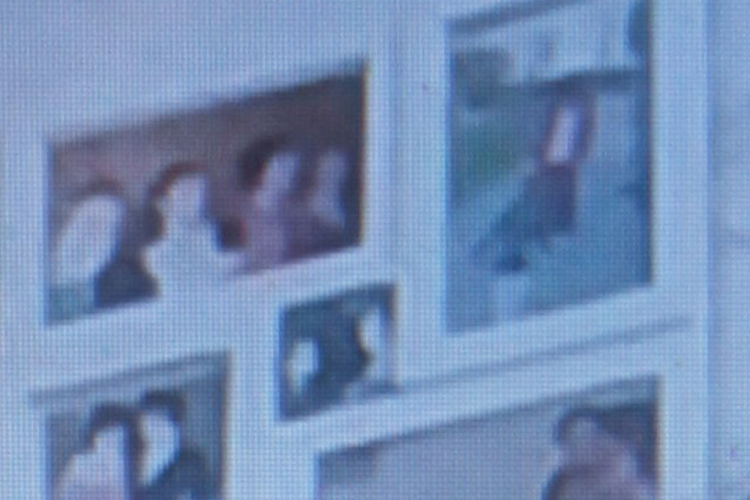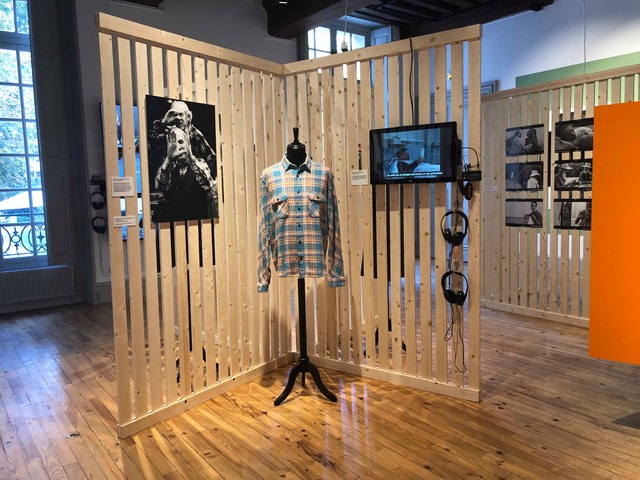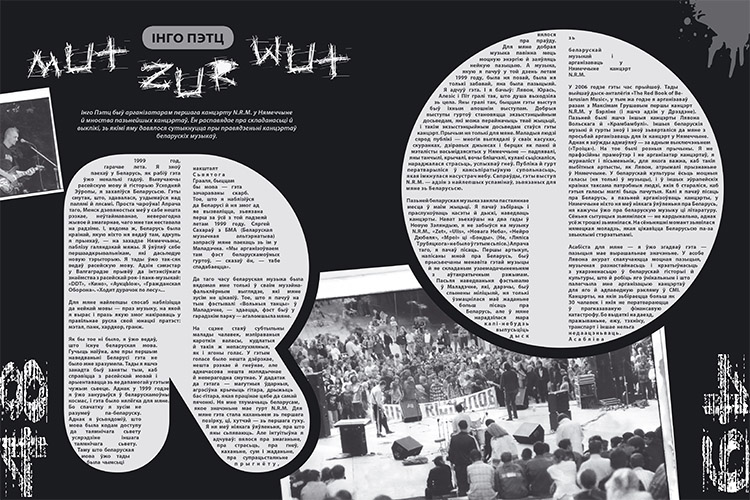
She Cannot Say Heaven, Vilnius-Minsk, 2011

Siarhiej Śabochin, Submission Practices \ 2011

Źana Hładko, Presence, fragment \ 2011

Uładzimir Łapo, Tekafrahmy \ 2011

A.R.Ć, Game Over seria \ 2003-2004

Alaksiej Łuniou, A Grandpa’s Pictures and A Mother’s Dress

Antanina Słabodćykava, 9 months and 22 days \ 2011
© Published in pARTisan #18’2012
At Home Among Strangers, a Stranger Among His Own
The project She Cannot Say Heaven by Gallery Сontemporary Art ‘Y’ was represented at International Contemporary Art Fair ARTVILNIUS’11 (13.07.2011 — 17.07.2011), where the project was awarded with the nomination ‘The Best Exposition by Foreign Gallery’. On July 28, 2011 the project was presented in Minsk, in Gallery ‘Y’ and become a cause of active discussion in Belarusian art community. What was the reason for Gallery’s success in Vilnius? And why this project was awarded with the attention of the international art community?
The success of the project She Cannot Say Heaven on ARTVILNIUS’11, where it became not only a winner, but also got attention of Lithuanian President, seems quite natural. The curators — Aliaksej Łuniou, Valancina Kisialova and Siarhiej Śabochin — brought to the fair not a collection of artworks ‘for sale’, but the exhibition with a clear defined concept. Thus, from the beginning the project was differed from a priori most projects in ARTVILNIUS’11.
The central subject of the project curators identified as the inner artist’s escapism ‘under conditions of hostile occupation in Belarus‘ [1]. The group of curators looked over the popular in academic circles idea that ‘a real creator’ should lock himself in an ivory tower. According to the curator’s conception, in Belarus the exile of artists from the society isn’t free. And the result of this opinion – artists’ ‘strategy of creative survival‘ in the situation of the isolation — became the objects of the exhibition.
Turning to the Belarusian context (it’s declared in the annotation) for foreign experts and visitors this concept was really attractive.
In my view, the cause of this ‘attractiveness’ lies in the fact that we (Belarusians) and our country (Belarus) are not like other peoples and countries. Because of certain historical circumstances, we are really different. Contrary to popular belief we are radically different from even our closest friends-enemies.
Therefore, everything which connected with Belarus abroad got the charm of otherness (like in Hollywood movies beauties have always fallen in love in strange guys). I don’t agree with Maksim Źbankou, but I like his idea that Belarus for foreigners looks like a ‘mysterious reserve of cultural mutation‘. The question about it’s bad or good for us (because give a certain historical chance) remains to be open [2].
After the triumph in ARTVILNIUS’11 the project was presented in Gallery Y. The reaction of Minsk audience was more cooler, down to appeal to ‘burn the exhibition and the gallery’. This situation is very typical for our culture field. Ardent art critics of the exhibition have adopted their usual self-propelled arguments like ‘it’s bad art, because it is not art’ or ‘it’s bad art because it’s the bad’.It’s interesting that real art in their understanding coincides with the forms that in the western artistic tradition called design and illustration. These critics feel quite comfortable in his dislike of the pre-reflective art, do not fit into their criteria.
At the opposite pole of opinion centered the circle of people who directly or indirectly relate to Gallery Y and to this project. Between these opposite shores lies a vast space of Belarusian Silent Majority, which is silent about everything, including the art.
The silent majority are they whisch appear in one of the central works of the exhibition — Submission Practices by Siarhiej Śabochin. Leaktightness of the artist’s escapist position is clearly manifested by the way of demonizing of they image in the covering texts. There are tracks of their presence, frozen in everyday things (Soviet stars, granary locks, empty pockets for festive red and green ideological flags) in the small-format black-and-white photographs. In addition to the photographs and the text Śabochin introduces into the exhibition space the real elements of the Belarusian material reality, which are the heritage of the socialist Belarusian past (conductors which stick out from the walls, sealed sewers).
Another work, which obviously objectifies materiality and our history is a ready-made A Mother’s Dress by Alaksiej Łuniou. This simple and typical thing is clearly characterized of its time. To us, accustomed to an aggressive sexuality in advertising and the visual image, in principle, it seems paradoxical that it’s absence in this image of the dress (after all, sex appeal is the only possible mode of the thing). This awareness can be seen in the ready-made by Luniou not only its materiality, but the idea of the era. This is only possible because of the idea of the project and the exhibition’s space.
The exposition is quite natural and logical moves from the revision of material culture (the works by Śabochin and Luniou) to its opposite — the religious consciousness. Presence by Źana Hładko includes the photos of religious attributes and symbols printed on the fabric, the multi-layered installation, where they overlap and interfere to form of visual combination. Those pictures that are on the bottom layer of the installation, remain hidden from a viewer, which suggests the idea that they are the most personal images of the religious consciousness of the artist.
Presence can be regarded as a metaphor for the religious consciousness in the XXI century, which has already been freed from the dogma of religious images. That’s why the artistic appropriation became possible. Considering venturing and passing on the lower layers of the installation, a viewer reproduces this religious reflection of the artist (after all, and there is a deeper reflection into itself in a positive sense).
Personal Icones by Alaksiej Łuniou have two sence because Belarusian tranlation of an ‘icon’ means an image as well as an icon. The work consists of a series of anonymous photographs, taken out from newspaper’s context, and which are for the artist are both a personal insult, and a source of inspiration. Another source of inspiration for an isolated subject becomes himself. This side of the insulation is seen in self-portraits by Haspar de Ło and Alaksiej Hubareu.
Two works by A.R.Ć. and a series of Tekafrahmy by Uładzimir Łapo are represented marginal measurement of escapism. Running, the authors cross the borders crossed by society (English ‘marginal’ means ‘boundary’). They find themselves in an area where no one had gone before. You can say that art is always a marginal radical escapist, so it only really runs away from reality.
A series of Tekafrahmy by Uładzimir Łapo, for example, is a posthumous casts of various insects, and one rat, cast in bronze. Such monumentalization ordinary and natural death can be regarded as a perfect antithesis to the bronze dead in the central squares of Minsk (dead, not only in the literal sense, but in the ideological and symbolic).
In spite of the positive impressions from the project, there is a little fragmentariness. Because of the wide range of different artistic strategies, some of it was difficult to comprehend — is it the author’s personal experience or his or her escapism? It seems that with the same success this work can be exposed in the frame of any other exhibition of any other concept. And it’s a very dangerous feeling for contemporary art.
In summary, we note that She Cannot Say Heaven is a really proffecional project with the current concept that has been voiced not only in the abstract, but through the language of contemporary art. Unfortunately, the majority of Belarusian visitors still come to expect from the exhibition a beautiful show and positive feelings. Just because they could not come under melancholic charm influence of the project.
Contemporary Art for the majority in Belarus is still unclear and ugly profiteering political and social problems. This is the reason for the paradoxical situation where Belarusian art is recognized abroad, but not at home. Between it and the audience appeared Belarussian wall of exclusion.
Fortunately, the story has a lot of positive examples that give grounds for hope that this exclusion will be eliminated. Voltaire, for example, should six times to escape from his native France to the fact that in 84 years back with triumph.
[1] From the project’s annotation
[2] The positive example about Belarusian otherness is the consept by Valancin Akudović ‘Belarus as a postmodern project
Photos © by Viktoria Śćarbakova, Gallery Y. More photos of the project in Gallery’s archive
Views expressed are those of the authors and may not reflect opinion of the editors. If you note any error, please contact us right away.






